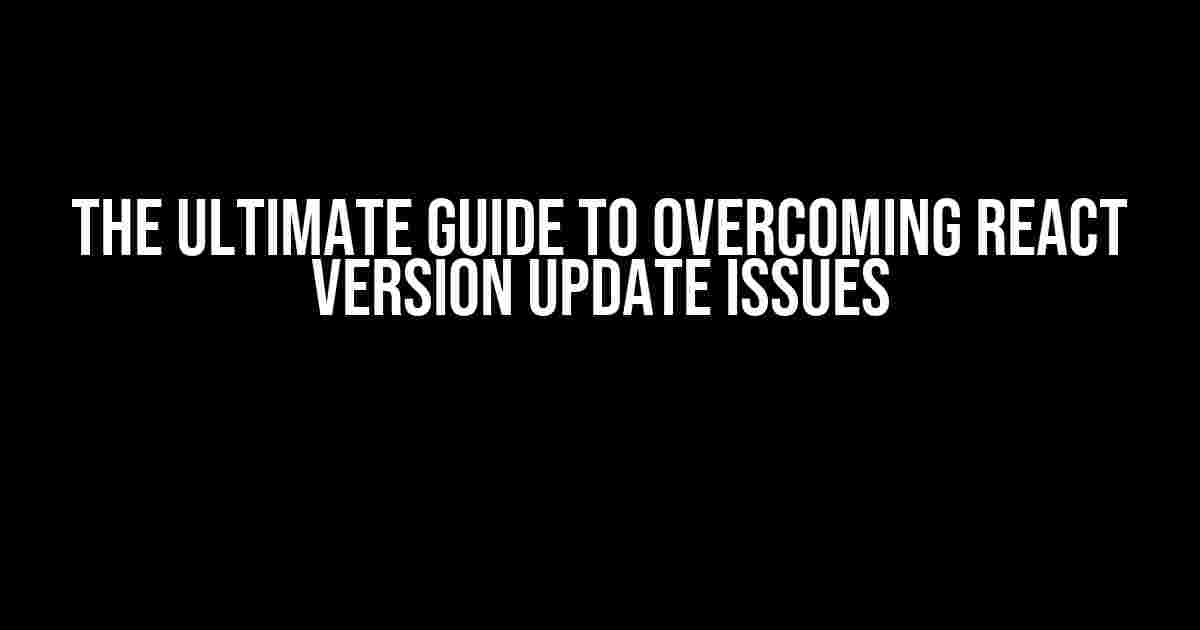Are you tired of encountering frustrating React version update issues that seem to pop up out of nowhere? You’re not alone! With each new React release, developers face the daunting task of adapting to changes, bug fixes, and sometimes, breaking changes. In this comprehensive guide, we’ll delve into the common problems that arise during a React version update and provide actionable solutions to get your project up and running smoothly.
Understanding the Causes of React Version Update Issues
Before we dive into the solutions, it’s essential to understand the underlying reasons behind these issues. Here are some common causes:
- Breaking Changes: When React introduces new features or changes existing ones, it can lead to incompatibility issues with your code.
- Dependency Conflicts: Updates can cause conflicts with other dependencies, resulting in errors or unexpected behavior.
- Plugin Compatibility: Plugins, such as Webpack or Babel, might not be compatible with the latest React version.
- Code Incompatibility: Your code might not be compatible with the new version, requiring significant updates.
Pre-Update Checklist: Prepare for a Smooth Transition
Before updating your React version, take the following steps to ensure a seamless transition:
- Backup Your Code: Create a backup of your entire project to avoid losing changes.
- Update Dependencies: Run
npm outdatedoryarn outdatedto identify outdated dependencies and update them. - Remove Unused Dependencies: Remove any unnecessary dependencies to prevent conflicts.
- Test Your Code: Run thorough tests to ensure your code is working correctly before updating.
Common React Version Update Issues and Solutions
Issue 1: unable to resolve dependency @react/cjs/react-dom@17.0.2
This error occurs when your project is using an outdated version of React DOM. To resolve this issue:
npm uninstall react-dom
npm install react-dom@17.0.2
Issue 2: TypeError: Cannot read property ‘useState’ of undefined
This error is often caused by incorrect imports or outdated dependencies. To fix this issue:
import React, { useState } from 'react';
// or
import React from 'react';
import { useState } from 'react';
Issue 3: Error: React Hook “useState” is called conditionally.
This error occurs when you’re calling a React Hook conditionally. To resolve this issue:
import React, { useState, useEffect } from 'react';
function MyComponent() {
const [count, setCount] = useState(0);
if (someCondition) {
setCount(10); // ✗ Avoid calling setCount conditionally
} else {
setCount(20); // ✗ Avoid calling setCount conditionally
}
return <div>{count}</div>;
}
Best Practices for React Version Updates
To minimize the risk of encountering issues during a React version update, follow these best practices:
| Best Practice | Description |
|---|---|
| Keep Your Dependencies Up-to-Date | Regularly update your dependencies to ensure compatibility with the latest React version. |
| Use a Version Manager | Utilize tools like nvm or yarn to manage different versions of Node.js and yarn. |
| Test Thoroughly | Perform exhaustive testing to identify potential issues before updating your React version. |
| Migrate Gradually | Update your project in stages, starting with smaller components and gradually moving to larger ones. |
Conclusion
React version update issues can be frustrating, but with the right strategies and approaches, you can overcome them. By understanding the causes of these issues, following a pre-update checklist, and applying best practices, you’ll be well-equipped to handle any challenges that come your way. Remember, a smooth transition is just a few steps away!
Have you encountered any React version update issues that we haven’t covered? Share your experiences and solutions in the comments below!
Frequently Asked Question
Get the inside scoop on React version update issues and how to tackle them like a pro!
What happens when I update my React version and my app breaks?
Don’t panic! When you update your React version, it’s not uncommon for your app to break. This can happen due to changes in the React API, deprecated methods, or compatibility issues with other dependencies. To fix the issue, start by reviewing the React changelog to identify the changes that might be affecting your app. Then, update your code to match the new API and refactor any deprecated methods.
How do I know which React version I should update to?
When deciding which React version to update to, consider the following factors: the latest stable version, the version supported by your dependencies, and the features you need. You can check the React documentation for the latest version and its features. Additionally, review your dependencies’ documentation to ensure they support the version you’re targeting. It’s essential to update to a version that balances new features with stability and compatibility.
What is the best approach to testing after a React version update?
Testing after a React version update is crucial to ensure your app works as expected. Start by running your existing tests to identify any failures. Then, perform manual testing to cover any critical user flows. Focus on testing components that might be affected by the update, such as those using deprecated methods or updated APIs. Finally, update your tests to match the new React version and ensure they cover the changes.
Can I use third-party libraries to simplify the React version update process?
Yes, you can use third-party libraries to simplify the update process. Libraries like React Upgrade Helper, React-Codemod, and jscodeshift can help you automate the process of updating your code to match the new React version. These libraries can also assist with identifying and fixing compatibility issues. However, it’s essential to carefully review the changes made by these libraries to ensure they align with your app’s requirements.
How can I prevent future React version update issues?
To prevent future update issues, adopt a proactive approach to maintaining your React app. Regularly review the React changelog and update your dependencies to ensure they’re compatible with the latest version. Write comprehensive tests to cover critical user flows, and use continuous integration to catch issues early. Additionally, consider implementing a versioning strategy, such as semantic versioning, to make it easier to manage dependencies and updates.
